Five Chinese brands at the same time (Chery, Haval, Exeed, Geely and Omoda) are among the top 10 best-selling cars in the first months of 2023.

Chinese producers are ousting South Korea in the Tatarstan passenger car market. Europeans and Japanese continue to lose positions. Lada still holds the lead in new car sales in Tatarstan and the Volga region, but the dynamics of the Russian auto giant are losing to Chinese rivals. Read the report of the analytical staff of Realnoe Vremya about which brands are behind KIA and Hyundai, what Tatarstan drivers choose, which Volga regions occupy the first car sales and what is happening with parallel imports.
Market distribution underway
The landscape of Tatarstan’s car market is changing rapidly, while American and European brands are disappearing, Chinese producers are seizing vacant niches. The best-selling cars change almost every month, once the invincible Koreans – KIA and Hyundai – will fall from the list of sales leaders.
Car sales that collapsed last time have not yet recovered: 2,382 passenger cars were sold in Tatarstan in January, down 26% from the same period in 2022 (3,233). Lada (+43%), Chery (+117%), KIA (-54.5%), Hyundai (-55%) and Haval (+67%) were among the top 5 new car sales in the republic during the first month of 2023.
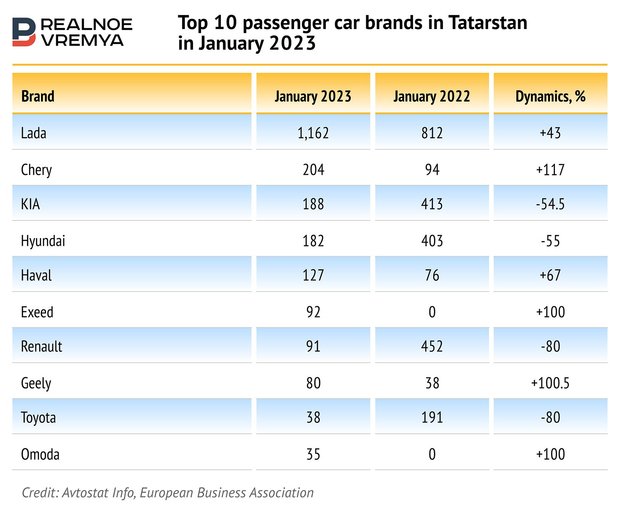
But the Chinese brands began to push the Koreans by rapidly losing sales from the top positions in February: Chery (+212%) and Haval (+87%). Given the dynamics of falling sales, once popular Korean brands Hyundai (-64%) and Kia (-70.6%) will be replaced by new Chinese brands Exeed and Omoda.
In February, 2,549 new cars were sold in Tatarstan, 31% less than in the same period last year (3,707). The overall downward trend in sales is here.
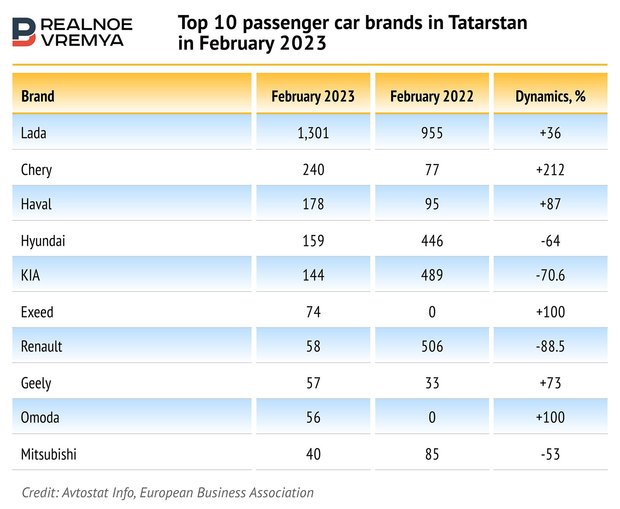
Despite the market decline, Tatarstan remains the leader in the Volga Federal District in new car sales. It is followed by Bashkortostan and Samara Oblast. During the first month of 2023, 11,289 passenger cars were sold in the Volga district, 33% less than in January 2022 (16,818).
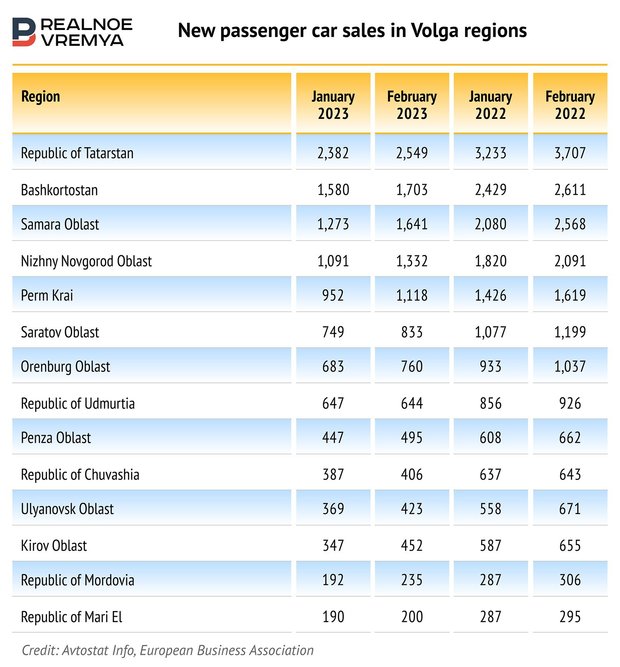
The best-selling new cars in the Volga Federal District in January include (+18% compared to last year), Chery (+72%), KIA (-68%), Haval (+47.8%) and Hyundai (- 60%). .4%).
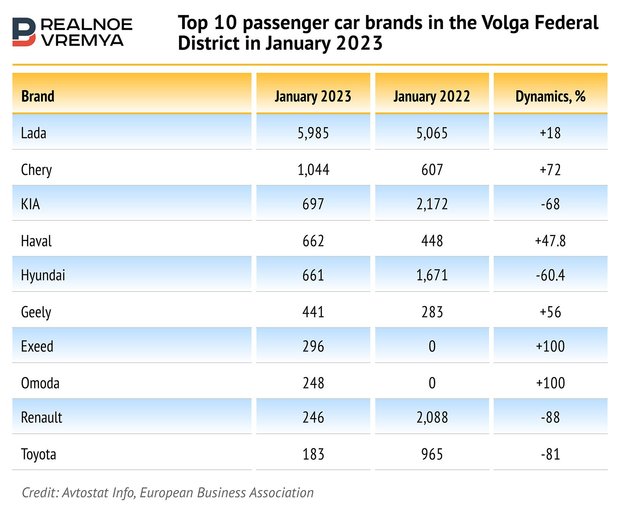
In February 2023, 12,791 passenger cars were sold in the Volga Federal District, which is 32.6% less than last February (18,990). The top 5 brands include Lada (+22.8%), Chery (+93%), Haval (+70%), KIA (-73%) and Hyundai (-66%). In addition, the Chinese Geely, Omoda and Exeed are rapidly increasing their sales in the Volga region are 6th at 8th position
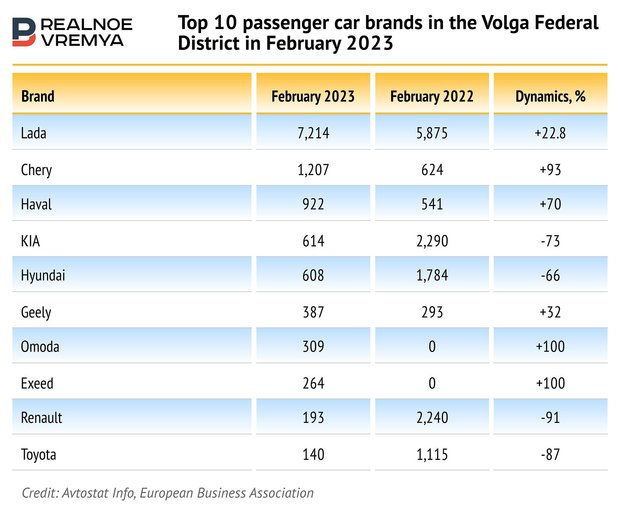
More than 2 million for the Chinese car
The share of Chinese car sales in Russia may reach 60% this year, the National Automobile Union does not rule out. This can happen due to the exit of European and American brands. Russian buyers have almost no choice.
The initial price of most Chinese cars exceeded 2 million rubles. Haval Jolion whose basic model is 1.9 million rubles is an exception. The second cheapest Chinese car in Russia Chery Tiggo 4 — costs from 2 million rubles. The average price of Omoda C5 is 2.57 million, Geely Coolray is 2.58 million, Chery Tiggo 7 Pro – 2.72 million, Haval F7 and Haval F7x are 2.8 million. Geely Altas Pro is 3.07 million rubles on average, while Chery Tiggo 8 Pro Max and Exeed TXL million are 4.04 and 4.42 million rubles respectively.

Customers mostly buy Lada (61.6%), Haval (5.5%), Renaut (4.8%), KIA (4.6%) and Chery (4.3%) from KAN AVTO.
The press service of TTS said that Lada, Omoda, Chery, Haval and Exeed were the most popular brands in Tatarstan, while Lada, Omoda, Chery, Renault and Exeed are found in all cities where they are present.
AvtoVAZ to maintain leadership in sales
“In 2023, several factors will influence the automobile market. First is the state of the economy and consumer incomes. If they are low, this will influence the unwillingness to make large purchases, including cars. Secondly, the state of the car market will depend on the state of the car industry, what models it will offer, and I mean both Russian producers and car companies from other countries” , lists Dmitry Baranov, the main expert of Finam Management. “Thirdly, it will matter how it will be possible to establish the parallel import of cars of those brands that suspended operations in the country.”
Also, according to him, state support measures for the car market and loan conditions will be important. The spread of environmental moods in society and the emergence of a wide line of cars with non-traditional engines (electric, gasoline, hybrid) can also influence the market.

Overall, auto sales in Russia in 2023 may be higher than last year, but Russian auto markets may take several years to recover.
New players from Iran and India to enter the market

“720-780,000 cars can be sold in Russia in 2023. The market can grow by 15-25% compared to 2022 (626,000),” predicts Azat Timerkhanov. “But other scenarios cannot be ruled out: optimistic (more than 30% growth) and pessimistic (up to 5% decline). High car prices are now playing against the market, but the fact that the car industry ‘automobile in the country is starting to revive it plays into their hands: we see the launch of new factories and hear announcements of future launches.’
“People need to drive something and the average person needs to buy a new car. The likelihood that the corporate segment — taxi and car sharing — will make a solid contribution to the market this year is high,” he points out.
The expert also expects the arrival of new players: from the PRC, Iran and India. “Imports are growing. At the same time, we must not forget the possible growth of exchange rates to which the market responds negatively and the continuous deficit of cars”, comments Timerkhanov. “Parallel importation, which we call alternative, cannot compensate for the number of brands that have disappeared. There are also risks here: other models are imported, buyers are not familiar with them, they are also more expensive. But the share of those imports is growing a bit: it accounted for 11% of total new car sales in February. In addition, official imports (almost all Chinese) maintained 29%.”

Foreign cars, of course, will also remain on the Russian market in general, the so-called “Russian foreign cars” that were made on the territory of Russia will be (almost) gone, he adds. Of course, foreign cars will be resold on the second-hand market for many years.
Yulia Garayeva, Syumbel Gubaydullina
Tatarstan


